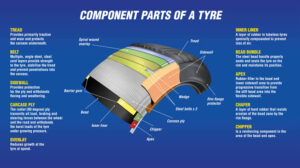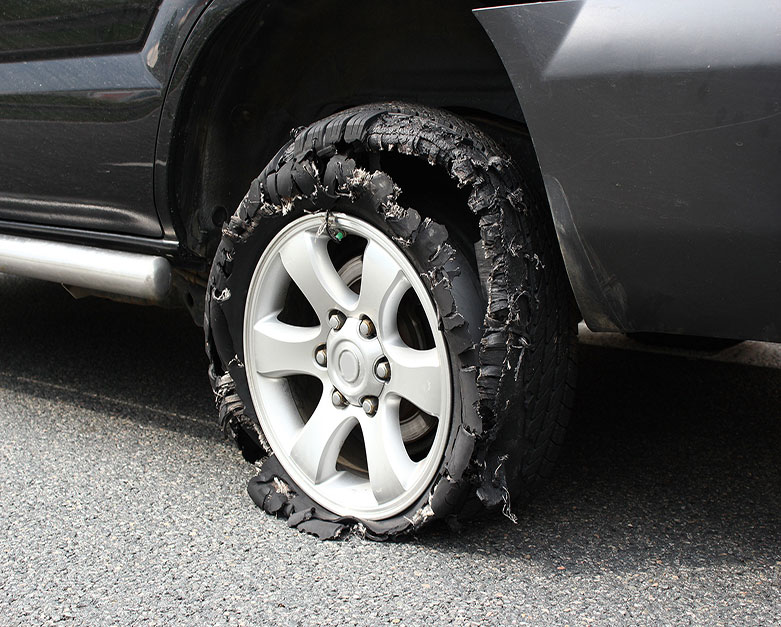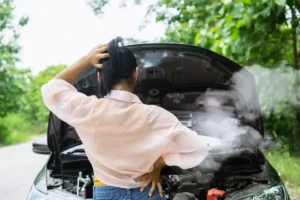A few weeks ago (here), we discussed how important tyres are; they carry the weight of your vehicle, grip the road, and absorb shocks from bumps and potholes. But even though they are so important, many people forget about them until something goes wrong. Tyre failures can be dangerous, causing accidents, expensive repairs, or even injuries.
Today, we’ll talk about why tyres fail, how to stop it from happening, and what to do if it happens to you. We’ll also look at the different parts of a tyre and how they can cause problems.
Parts of a Tyre and How They Can Fail
To understand why tyres fail, it’s helpful to know the different parts of a tyre and what they do. Each part has a job, and if one part fails, it can cause big problems.

1. Tread
The tread is the part of the tyre that touches the road. It gives you grip and helps water flow away so you don’t slide in the rain.
–Failure Risk: If the tread wears down, your car won’t grip the road well, especially in wet or icy conditions. This can make you skid or even cause a blowout.
2. Sidewall
The sidewall is the side of the tyre. It supports the tyre and protects it from damage.
– Failure Risk: If the sidewall gets cuts, bulges, or cracks, it can weaken the tyre and cause a blowout. Hitting potholes or curbs often damages the sidewall.
3. Bead
The bead is the edge of the tyre that sits on the wheel. It keeps the tyre attached to the wheel and seals the air inside.
– Failure Risk: If the bead is damaged or not fitted properly, air can leak out, causing the tyre to go flat or even come off the wheel.
4. Carcass (Body Plies)
The carcass is the inside structure of the tyre. It’s made of layers of fabric or steel cords that give the tyre strength and flexibility.
– Failure Risk: If these layers break or separate, the tyre can bulge, vibrate, or even burst.
5. Belt Package
The belt package is under the tread. It’s made of steel or fabric belts that help the tread stay stable and last longer.
– Failure Risk: If the belts break or separate, the tread can wear unevenly, and the tyre might vibrate or lose performance.
6. Inner Liner
The inner liner is a rubber layer inside the tyre that keeps the air in. It works like a built-in tube for tubeless tyres.
– Failure Risk: If the inner liner gets punctured or cracked, air can leak out slowly or suddenly, causing the tyre to go flat.
Common Causes of Tyre Failures
1. Too Little or Too Much Air (Underinflation/Overinflation)
If your tyres don’t have the right amount of air, they can fail. Too little air makes the tyre overheat and can cause a blowout. Too much air makes the tyre stiff and more likely to get punctured.
2. Punctures and Damage
Sharp objects like nails, glass, or rocks can puncture your tyre, causing a slow leak or a sudden blowout. Hitting curbs or potholes can also damage the tyre.
3. Worn or Old Tyres
Over time, the tread on your tyres wears down, making them less grippy and more likely to fail. Even if the tread looks okay, tyres older than six years can crack and weaken.
4. Overloading
Putting too much weight in your car puts extra stress on the tyres, making them overheat and fail. Always check your car’s weight limit and make sure your tyres can handle the load.
5. Poor Maintenance
If you don’t take care of your tyres—like rotating them, checking alignment, and balancing them—they can wear unevenly and fail sooner.
6. Manufacturing Problems
Sometimes, tyres have defects from the factory. This is rare, but it can happen. Check for recalls and buy tyres from trusted brands.
How to Prevent Tyre Failures
1. Check Tyre Pressure Often
Use a tyre pressure gauge to check the air in your tyres at least once a month and before long trips. Your car’s manual will tell you the right pressure. For more information, click here
2. Look for Damage
Regularly check your tyres for cuts, cracks, bulges, or objects stuck in them. If you see damage, get it fixed or replace the tyre.
3. Rotate and Balance Tyres
Rotate your tyres every 8,000 to 10,000 kilometres to make sure they wear evenly. Also, check the balance and alignment of your tyres.
4. Don’t Overload Your Car
Stick to your car’s weight limit and avoid carrying too much. If you’re carrying heavy loads, make sure your tyres can handle it.
5. Replace Old Tyres
Even if the tread looks good, replace tyres that are more than six years old. You can find the manufacturing date on the sidewall (a four-digit code showing the week and year it was made).
6. Drive Carefully
Avoid potholes, curbs, and rough roads. Drive at safe speeds and keep a safe distance from other cars to avoid debris.
What to Do During a Tyre Failure
Even with good care, tyre failures can still happen. Here’s what to do if it happens to you:
1. Stay Calm and Keep Control
If you hear a loud noise or feel your car pulling to one side, stay calm. Hold the steering wheel tightly and don’t brake suddenly or turn sharply.
2. Slow Down Gradually
Take your foot off the gas and let the car slow down on its own. Don’t slam on the brakes, as this can make you lose control.
3. Pull Over Safely
Once you have control, signal and move to the side of the road. Turn on your hazard lights to warn other drivers.
4. Check the Damage
If it’s safe, look at the tyre to see how bad the damage is. Don’t drive on a flat or badly damaged tyre.
5. Call for Help
If you can’t change the tyre yourself, call for roadside assistance or a tow truck. Always keep a spare tyre, jack, and tools in your car.
In conclusion, tyre failures are serious and can put you in danger on the road. By knowing the causes and taking care of your tyres, you can reduce the risk of failure. Check your tyres often, keep them at the right pressure, and drive carefully. Remember, your tyres are the only part of your car that touches the road—so take good care of them!
Stay safe, and happy driving!
—
Have you ever had a tyre fail? Share your story and tips in the comments below! Don’t forget to follow our website for more car tips and advice.




